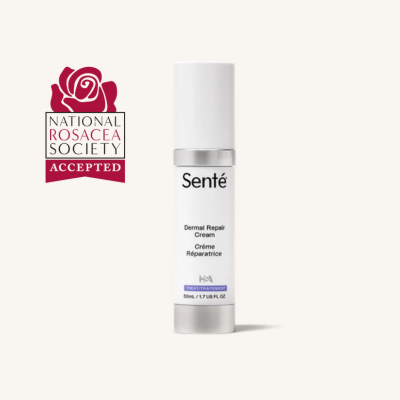Rosacea: Types, Triggers, & Treatments
Rosacea is a chronic and common genetic skin condition that is characterized by persistent facial redness and flushing along with bumps, pimples, and visible blood vessels. While there is no cure for rosacea, there are many proven treatment options.
In this blog, we’ll explore:
Facts about Rosacea (including types, triggers, and treatments)
Product Recommendation
Treatment Recommendation
Subtypes of Rosacea
There are four subtypes of rosacea that can be seen alone or overlapping with other types.
Erythematotelangiectatic Rosacea: Redness, flushing, and visible blood vessels of the central face.
Redness and flushing can come and go and be worse some days than others due to everyday triggers, including products, foods, drinks, stress, and weather.
Sensitive skin that is easily irritated by different products and dry weather.
Underdiagnosed and undertreated.
Improved with the use of the correct over-the-counter hydrating sensitive skin products and avoidance of over-the-counter exfoliating and irritating products such as retinoids, benzoyl peroxide, salicylic acid, and more.
Rx topical treatment creams containing oxymetazoline can reduce flushing and redness significantly.
Laser treatment to reduce capillaries and small broken blood vessels of the central face can help tremendously.
Papulopustular Rosacea: Redness, swelling, and acne-like breakouts.
Most commonly diagnosed because of more obvious presentation.
Often confused with acne but can be differentiated by:
Location/Distribution: Rosacea is usually on the central face, nose, and cheeks, while acne is often in the T-zone or lower face, jawline, and peripheral face.
Appearance: Rosacea usually has a background of redness and flushing with overlying red bumps or pimples, while acne has the combination of clogged pores and blackheads, pimples, and pustules.
Easily treated with a combination of oral and topical antibiotic and anti-inflammatory medications.
Phymatous Rosacea: Skin thickens and has a bumpy texture, usually on the nose.
This is a rare form of rosacea that develops over the course of many years from chronic papulopustular rosacea.
Ocular Rosacea: Eyes are red and inflamed; they may feel dry and irritated.
It can occur alone or in combination with erythrotelangiectatic rosacea or papulopustular rosacea.
Underdiagnosed and undertreated.
Best treated with oral Doxycycline.
Rosacea Triggers
Rosacea is a chronic condition but can come and go due to different common daily triggers, which include:
Dry climates
Extreme hot or cold temperatures
Excessive exposure to sunlight
Drinking alcohol
Eating spicy foods
Certain ingredients in skin care products (alcohol, urea, fragrance, glycolic acid, sodium laurel sulfate, menthol, lactic acid, camphor, and retinols)
Rosacea Treatments
Oral prescription anti-inflammatory medications, such as prescription doxycycline, are effective in papulopustular rosacea and are the gold standard treatment for ocular rosacea.
Topical prescription anti-inflammatory medications, such as Metronidazole and Ivermectin, exfoliating ingredients such as azelaic acid, and vasoconstricting medications such as Oxymetazoline.
Over-the-counter anti-inflammatory products can reduce redness, including heperan sulfate, niacinamide, ceramides, hyaluronic acid, green tea extract, and licorice extract.
Sun protection, daily SPF.
Laser treatments to reduce redness and broken blood vessels.
RECOMMENDATIONS FROM OUR TEAM
Product Recommendation: Senté Dermal Repair Cream
Hydrating repair cream for reduced appearance of redness and visibly healthier-looking skin. Contains a unique patented ingredient, Heparan Sulfate Analog (HSA).
Accepted by the National Rosacea Society
Clinically proven to:
Reduce visible redness and sensitivity after only 4 weeks.
Deeply hydrates and renews skin.
Promotes healthier, more even-looking skin.
Improves the appearance of fine lines and wrinkles.
Treatment Recommendation: Intense Pulse Light (IPL) Laser
A non-invasive laser treatment that can significantly reduce overall redness and completely remove broken blood vessels on the face, most commonly seen on the nose, chin, and central cheeks.
How it works:
Specific wavelengths of light are delivered to the skin with a crystal handpiece in pulses that are absorbed by blood vessels beneath the skin without harming the surrounding skin.
The heat absorbed by the light destroys the small vessels and causes them to disappear slowly through your body’s natural healing process.
Our team recommends a series of 3 treatments approximately 4-6 weeks apart.
Results:
Reduce the appearance of redness and broken blood vessels.
Reveal even-colored skin with reduced discoloration.



